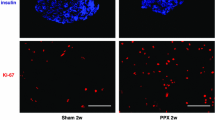Summary
We examined the effects of aging on the uptake of tritiated thymidine (3H-TdR) by the different cell types of the pancreas of the Syrian golden hamster. Animals, 8-22-wk-old, received3H-TdR (2 μCi/gm) intraperito-neally and were sacrificed 1 h later. Pancreatic tissue from each animal was processed for autoradiography. The percentage of acinar cells labeled with3H-TdR was 1.17 ±0.26 at 8-wk-old and steadily diminished to 0.02 ±0.00 at 22 wk. The percentage of ductular and islet cells labeled with3H-TdR at 8 wk was 0.24±0.24 and 0.16±0.01, respectively and at 22 wk was 0.13 ± 0.09 and 0.18 ±0.01, respectively. In contrast with acinar cells, the percentage of ductular and islet cells labeled with3H-TdR between 10- and 20-wk-old showed considerable variability. In the major ducts in the head of the gland, the number of epithelial cells per mm duct length labeled with3H-TdR did not change throughout the study; 3.25 ±1.5 at 8 wk and 3.35 ±1.3 at 22 wk. It is concluded that acinar cell growth is an inverse function of age between 8-22 wk and that differentiated cell types in the pancreas of the Syrian golden hamster are capable of incorporating3H-TdR during the S-phase of the cell cycle.
Similar content being viewed by others
References
Medline A and Farber E. The multi-step theory of neoplasia, Anthony PP and MacSween RNM, Eds., Recent advances in histopathology, Churchill Livingston, New York, 1980; 19–34.
Solomon TE. Regulation of exocrine pancreatic cell proliferation and enzyme synthesis, John LR, Ed., Physiology of the gastrointestinal tract, Raven Press, New York, 1981; 873–892.
Homburger F. The Syrian golden hamster in chemical carcinogenesis research. Prog Exp Tumor Res 1968; 10: 137–164.
Pour P, Mohr U, Cardesa A, Althoff J, and Kruger FW. Pancreatic neoplasms in an animal model: Morphological, biological and comparative studies. Cancer 1975; 36: 379–389.
Leblond CP and Walker WA. Renewal of cell populations. Physiol Rev 1956; 36: 255–276.
Kopriwa BM and Leblond CP. Improvements in the counting technique of radioautography. J Histochem Cytochem 1961; 10: 269–284.
Polyakova TL DNA synthesis in various cells of the exocrine part of the intact albino rat pancreas. Byulletin’ Eksperimental’ noi Biologic i Meditsiny 1974; 78: 117–120.
Ogrowsky D, Fawcett J, Althoff J, Wilson BB, and Pour P. Structure of the pancreas in Syrian hamsters. Scanning electron-microscopic observations. Acta Anat 1980; 107: 118–121.
Elasser HP, Lutcke H, and Kern HF. Acinar and duct cell replication and regeneration. Go VLW, Gardner JD, Brooks FP, Lebenthal E, DiMagno EP, and Scheele GA, Eds., The exocrine pancreas, Raven Press, New York, 1986; 45–53.
Malaisse-Lagae F, Ravazzola M, Robberecht P, Vandermeers A, Malaisse WJ, and Orci L. Exocrine pancreas: Evidence for topographic partition of secretory function. Science 1975; 190: 795–797.
BenDayan M and Ito S. Immunohistochemical localization of exocrine enzymes in normal rat pancreas. J Histochem Cytochem 1979; 27: 1029–1034.
Bordi C. Cohn I and Hastings PR, Eds., Pancreatic cancer, UICC Technical Report Series, Report No. 12, volume 57. Geneva, 1981; 34–37.
Baylin SB. Hesch R-D and Atkinson MJ, Eds., Peptide hormones in immunology and oncology, Raven Press, New York, 1985; 1–12.
Pour P, Takahashi M, Donnelly T, and Stepan K. Modification of pancreatic carcinogenesis in the hamster model. IX. Effect of pancreatitis. JNCI 1983; 71: 607–613.
Rosenberg L, Brown RA, and Duguid WP. A new approach to the induction of duct epithelial hyperplasia and nesidioblastosis by cellophane wrapping of the hamster pancreas. J Surg Res 1983; 35: 63–72.
Hellerstrom C and Swenne I. Growth pattern of pancreatic islets in animals. Volk BW and Arquilla ER, Eds., The diabetic pancreas, Plenum, New York, 1985; 53–80.
Author information
Authors and Affiliations
Rights and permissions
About this article
Cite this article
Rosenberg, L., Duguid, W.P. & Vinik, A.I. The pancreas of syrian golden hamsters. Int J Pancreatol 4, 273–280 (1989). https://doi.org/10.1007/BF02938463
Received:
Accepted:
Issue Date:
DOI: https://doi.org/10.1007/BF02938463




